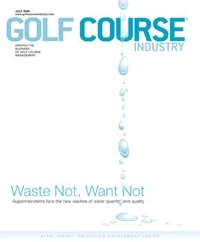Q While preparing for the PGA Tour’s Tournament Players Championship, golf course superintendent Fred Klauk used an interesting method to light the way for his staff early in the morning so they could see where they were mowing. What lighting devices were used?
A Other host superintendents have used Department of Transportation lighting units. However, these units are heavy, noisy, fuel-powered and not moved easily, and often result in complaints from neighbors. Additionally, the light is so bright it’s incredibly difficult to look into. Klauk’s solution was inflatable lighting units made by Prism Lighting Services in Jacksonville, Fla. The benefits are:
- One person can raise the metal halide light as high as 15 feet in a few seconds without using a metal structure.
- The brightness is equivalent to 1,000 watts.
- A series of fans inflate and support the structures, projecting a low level light and making the system quiet.
- The structure is enlarged vertically and can be used in a narrow space.
- Support ropes and sand bags provide anchorage, which allow the device to be operated in wind gusts as fast as 25 mph.
- The system can be powered by an autonomous generator or irrigation system electronics.
- The weight and dimension make it possible for one person to operate and transport the unit with a small utility vehicle and trailer.
- The light projected is easy on the equipment operator’s eyes, especially in early morning darkness.
Q The practice teeing ground during the Tournament Players Championship is huge – 550 feet by 175 feet. Yet, incoming golf course superintendent Tom Vlach installed an artificial practice surface from end to end. With a teeing ground so large, why is there a need for an artificial surface?
A At The Players Club, every detail is attended to so the competitors can concentrate on their craft completely. A perfect and spacious natural surface is essential for their practice routine. A flawless practice surface is vital for the competitors’ daily routine during the Championship.
Vlach placed a strip of artificial turf within the boundaries of the regular practice teeing ground to provide a maintained, easy-to-use surface for resort guests. The material, from Turf Evolutions of Georgia, is a great alternative for play leading up to and after the event. The turf is relatively easy to install, which the company does.
From Vlach’s perspective, it’s a low-maintenance material that requires no topdressing or additional servicing other than blowing off organic debris that accumulates on the surface. It’s easy on the physical components of long practice sessions. For example, it’s soft under foot, making it relaxing to stand for a long period of time and hit balls. It’s also less stressful on the players’ muscles and reduces the impact to the joints of those who practice their flaws for an extended period of time.
Members and guests say the surface has a good playing feel, similar to real grass. Vlach can let members and guests practice on the artificial turf when the existing teeing ground is too wet or dormant during the off season. The only drawback is the inability to use a longer tee.
Q With The Players Championship now held in May, were there any maintenance adjustments Klauk and his staff needed to make in their agronomic or mechanical programs to prepare the new ultradwarf playing surfaces?
A With the new Mini Verdi putting surfaces, preparations and attention to mowing details within the equipment facility increased, says Mark Sanford, equipment manager of the Tournament Players Club.
Sanford reviews the agronomic requirement for additional light sand topdressing in the months leading up to the tournament. For upright growth to occur, the thickness of the mower bedknives during pretournament weeks becomes vital. Thinner bedknives are used to reduce dragging, streaking and uneven cut lines. Entering the championship week, sand topdressing is eliminated and even thinner bedknives are used, especially when mowing below 0.1 inch.
Moisture content in the air and in the turf creates a fat and puffy leaf tissue. This swelling can alter the quality of cut daily, requiring Sanford to recheck the height of cut constantly.
Sanford ensures each putting surface is walked and checked before mowing to remove organic debris and sand. He also checks to make sure there are no coins, ball markers, long tees or items stuck in the putting surface that can damage the bedknife, reel and quality of cut.
To ensure the height of cut remains the same throughout the morning and afternoon, all transport vehicles and trailers remain on the smooth and even cart paths. Having the vehicles remain on a smooth surface eliminates the mowing unit from bouncing up and down on the trailer and upsetting the height of cut, prevents damage to the unit in any way and reduces gas from being spilled or overflowing from the tank. Sanford suggests using a dipstick when filling equipment with gas to measure tank depth to ensure the fuel level is set 1 inch below the tank cap level. This reduces spills onto the turf. GCI
Tim Moraghan is principal of Aspire Golf Consulting in Long Valley, N.J. He can be reached at tmoraghan11@comcast.net or 908-635-7978.

Explore the July 2008 Issue
Check out more from this issue and find your next story to read.
Latest from Golf Course Industry
- From the publisher’s pen: Conscientious of a bigger role
- Bernhard and Company partners with Laguna Golf Phuket
- Terre Blanche showcases environmental stewardship
- VIDEO: Introducing our December issue
- Bernhard and Company introduces Soil Scout
- Nu-Pipe donates to GCSAA Foundation’s Centennial Campaign
- GCSAA enhances golf course BMP tool
- Melrose leadership programs sending 18 to 2026 GCSAA Conference and Trade Show





